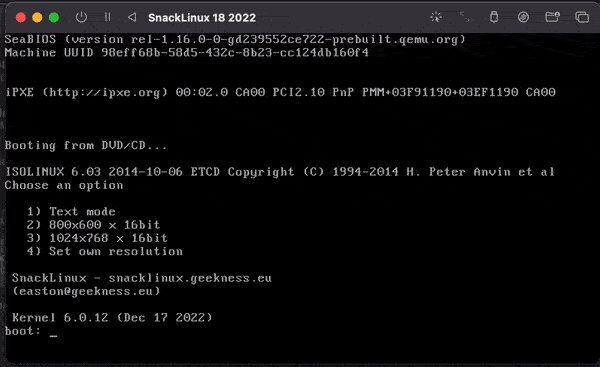https://github.com/snacsnoc/snacklinux
Linux distribution for lazy people
https://github.com/snacsnoc/snacklinux
binutils busybox linux linux-distribution linux-distros musl musl-libc operating-system syslinux
Last synced: 5 months ago
JSON representation
Linux distribution for lazy people
- Host: GitHub
- URL: https://github.com/snacsnoc/snacklinux
- Owner: snacsnoc
- License: gpl-3.0
- Created: 2013-03-10T01:43:31.000Z (over 12 years ago)
- Default Branch: master
- Last Pushed: 2025-02-10T08:31:30.000Z (5 months ago)
- Last Synced: 2025-02-10T09:30:51.151Z (5 months ago)
- Topics: binutils, busybox, linux, linux-distribution, linux-distros, musl, musl-libc, operating-system, syslinux
- Language: Makefile
- Homepage: http://snacklinux.geekness.eu/
- Size: 67.9 MB
- Stars: 16
- Watchers: 5
- Forks: 2
- Open Issues: 0
-
Metadata Files:
- Readme: README.md
- License: COPYING
Awesome Lists containing this project
README
SnackLinux
===========

:computer: SnackLinux is an ultra minimal Linux distribution for 486 CPUs
:wrench: Linux 4.4 kernel with BusyBox, musl, and Bash
:small_orange_diamond: Built from scratch with that can run with 8MB RAM
:file_folder: Bash-based package manager [fbpkg](https://github.com/snacsnoc/fbpkg)
:package: x86 has 31 packages, including a working gcc toolchain and other GNU utilities
Visit [snacklinux.geekness.eu](http://snacklinux.geekness.eu) for downloads, wiki and more information about SnackLinux.
______
# Intro
-------------------------------
SnackLinux runs a barebone kernel with downloadable extra kernel modules.
The philosophy is to create a completely hackable Linux system using standard GNU utilities, controlled by makefiles. The system installs to a local directory, anything in there is included in the final build. Imagine [Linux From Scratch](https://www.linuxfromscratch.org/) but with a lot less features. If you've ever wanted to build your own Linux distribution in 30 minutes, this is the project you're after.
Originally designed to bring the latest software to vintage i486 systems, SnackLinux is built for minimal size and low RAM usage. You can use virtualization or real hardware. The x86 bootable ISO is under 5MB.
__Archtechtures supported:__
* x86/i486 (current, works)
* arm64 (not maintained, works) See [Fluxflop](https://github.com/snacsnoc/fluxflop)
* amd64/x86_64 (not maintained, but works with effort)
# Getting started
-------------------------------
You can use prebuilt ISOs, a flashable disk image for use with Compact Flash or compile from source.
See [Getting started](http://snacklinux.geekness.eu/getting-started) to download ISOs and a quick start guide.
# Compiling SnackLinux from source
-------------------------------
# Build system
* Linux is preferable to build with
## Debian
```
apt-get install build-essential git libgmp-dev libmpc-dev flex bison bc
```
_Optional:_
```
apt-get install genisoimage #used for generating x86 ISO images
```
## Mac OS*
* Mac OS is **incredibly** difficult to get working alone to build the kernel, otherwise cross-compiling packages works
* An alternative to a tradtional VM is to use something like [krunvm](https://github.com/containers/krunvm)
### gcc
```
arch -arm64 brew install gcc@12
```
If you have an alternate version of gcc installed, create symlinks:
```
cd /opt/homebrew/bin
ln -s gcc-12 gcc
ln -s g++-12 g++
```
# Toolchain
## Build your own
Compile your own toolchain with [musl-cross-make](https://github.com/richfelker/musl-cross-make.git)
`git clone https://github.com/richfelker/musl-cross-make.git`
### x86
```
TARGET=i486-linux-musl make
TARGET=i486-linux-musl make install
```
#### arm64
```
TARGET=aarch64-linux-musl make
TARGET=aarch64-linux-musl make install
```
Toolchain installs to `output/`
Add the toolchain to your shell's PATH:
```
export PATH=$PATH:/path/musl-cross-make/output/bin
```
# Building SnackLinux
After our toolchain is built, we can build SnackLinux which includes the kernel and user utilities.
## Environment vars
`JOBS`
Set number of parallel jobs to create, defaults to 8
Example:
`export JOBS=12`
`ROOTFS_PATH`
Path to SnackLinux root filesystem, defaults to `/opt/snacklinux_rootfs`
### Architechtures
```
TARGET=aarch64
TARGET=i486
TARGET=x86_64
```
Defaults to `i486`
__Example, building for arm64:__
`export TARGET=aarch64 JOBS=4`
## Versions
See `defs.sh` for defined kernel and package versions
## Getting started
* Download source tars and link
`bash ./download_prereq.sh `
* Create target install directory
`mkdir /opt/snacklinux_rootfs`
* Compile the kernel
_See `configs/linux` for available configs_
```
make kernel
```
* Build musl, Bash and BusyBox
```
make system
```
* Install to `/opt/snacklinux_rootfs` directory
```
make install
```
Next step: [booting](#Booting)
#### Compile individual packages
You can alternatively build the individual software and install at your will.
#### Linux
```
make kernel
```
#### musl
```
make musl
```
#### BusyBox
```
make busybox
```
#### Bash
```
make bash
```
#### Binutils (optional)
```
make binutils
```
#### Syslinux
```
make syslinux
```
#### Python (experimental)
```
make python
```
If you would also like to install binutils, use:
```
make binutils-install
```
#### stripping symbols
This target strips all debug symbols files matching LSB executable, shared object or ar archive
```
make strip-fs
```
#### additional packages
See [building packages](http://snacklinux.geekness.eu/packages)
# Booting
Prerequisites:
#### Base files (/etc)
```
git clone https://github.com/snacsnoc/snacklinux-base.git
cp -R snacklinux-base/rootfs/* /opt/snacklinux_rootfs/
```
### Create /dev files and required directories
Run as root:
```
bash ./tools/create_dev.sh
```
### fbpkg (package manager)
```
git clone https://github.com/snacsnoc/fbpkg.git
cp fbpkg/src/fbpkg /opt/snacklinux_rootfs/usr/bin
chmod +x /opt/snacklinux_rootfs/usr/bin
```
# Booting
## ISO (x86)
Run `make iso` to generate a bootable ISO. The output ISO will be in `iso/`
Run `make iso-with-kernel` to generate a bootable ISO with the kernel in `/boot`. The output ISO will be in `iso/`
Note: you do not have to have the toolchain to create the ISO
## Flashable boot disk
You can generate a disk image suitable for flashing onto a Compact Flash card (using an IDE adapter) for deployment on real hardware.
Create an image of your preferred size:
```
dd if=/dev/zero of=snacklinux.img bs=1M count=450
```
Mount it and create a partition:
```
sudo losetup -Pf snacklinux.img
mkdir -p /mnt/snacklinux
sudo mount /dev/loop0p1 /mnt/snacklinux
echo -e "o\nn\np\n1\n\n\nw" | sudo fdisk /dev/loop0
sudo mkfs.ext2 /dev/loop0p1
```
Copy the root filesystem and install Syslinux bootloader:
```
cp -a /opt/snacklinux_rootfs/* /mnt/snacklinux/
sudo mkdir -p /mnt/boot/extlinux
# Copy the compressed kernel image if your rootfs does not include it
cp linux/arch/x86/boot/bzImage /mnt/boot/extlinux
cat << EOF > /boot/extlinux/extlinux.conf
DEFAULT linux
LABEL linux
KERNEL bzImage
APPEND root=/dev/hda1 rw noapic noacpi
EOF
# syslinux 6.03/6.04 is not reliable on old hardware, please use 4.07 and compile source
sudo extlinux --install /mnt/boot/extlinux
```
Install Syslinux MBR to the disk image:
```
sudo dd if=/usr/lib/EXTLINUX/mbr.bin of=/dev/loop0 bs=440 count=1
```
Finally unmount and detach:
```
sync
sudo umount /mnt
sudo losetup -d /dev/loop0
```
## qemu
Create a gzipped rootfs by running:
```
cd /opt/snacklinux_rootfs/; find . -print | cpio -o -H newc --quiet | gzip -6 > ~/rootfs.gz
```
Then boot in qemu:
### arm64:
Linux:
```
qemu-system-aarch64 -M virt,highmem=off -kernel linux/arch/arm64/boot/Image -initrd rootfs.gz -append "root=/dev/ram" -m 256 -serial stdio -boot menu=off -cpu max -nodefaults -boot d -device virtio-gpu-pci -device virtio-keyboard-pci,id=kbd0,serial=virtio-keyboard
```
Mac OS (Apple Silicon):
```
qemu-system-aarch64 -M virt,highmem=off -kernel Image -initrd rootfs.gz -append "root=/dev/ram" -m 128 -boot menu=off -cpu max -nodefaults -boot d -bios "/opt/homebrew/Cellar/qemu/7.1.0/share/qemu/edk2-aarch64-code.fd" -device virtio-gpu-pci -device virtio-keyboard-pci,id=kbd0,serial=virtio-keyboard -accel hvf
```
Run a VNC server with qemu:
`-vnc 12.34.56.78:0`
### x86:
```
qemu-system-i386 -cpu 486-v1 -m 256 -kernel bzImage -initrd rootfs.gz -append "root=/dev/ram rdinit=/sbin/init"
```
### x86_64:
```
qemu-system-x86_64 -m 256 -kernel bzImage -initrd rootfs.gz -append "root=/dev/ram rdinit=/sbin/init"
```
# Packages
Read the [Packages page](http://snacklinux.geekness.eu/packages) for building packages.
For SnackLinux's package manager fbpkg, see [here](https://github.com/snacsnoc/fbpkg).
# Hacking
Edit anything in `/opt/snacklinux_rootfs`, it is the root filesystem.
The kernel can also be recompiled to fit your needs.
The `boot/isolinux` directory is where ISOLINUX resides, edit the menu to adjust to your needs.
# Contributing
SnackLinux is a personal project, but I welcome contributions from the community. If you have ideas, feedback, or code changes that can improve SnackLinux, your input is valued.
Thanks
------
Mike Chirico for http://souptonuts.sourceforge.net/cdrom.htm
Tiny Core Linux distribution for inspiration and documentation http://tinycorelinux.net
Gregor Richards for the many Musl compiler scripts https://github.com/GregorR
Linux From Scratch for excellent documentation http://www.linuxfromscratch.org/
The Arch Linux wiki https://wiki.archlinux.org/
Rich Felker for creating musl-cross-make and make building so easy https://github.com/richfelker/musl-cross-make
Here are links to the software used in SnackLinux:
[syslinux](https://www.kernel.org/pub/linux/utils/boot/syslinux/)
[linux](https://www.kernel.org)
[busybox](http://www.busybox.net/downloads/)
[bash](http://ftp.gnu.org/gnu/bash/)
[fbpkg](https://github.com/snacsnoc/fbpkg)
[binutils](http://ftp.gnu.org/gnu/binutils/)
[musl](http://www.musl-libc.org/)
# Resources
http://port70.net/~nsz/32_dynlink.html
https://gcc.gnu.org/onlinedocs/gcc/Optimize-Options.html